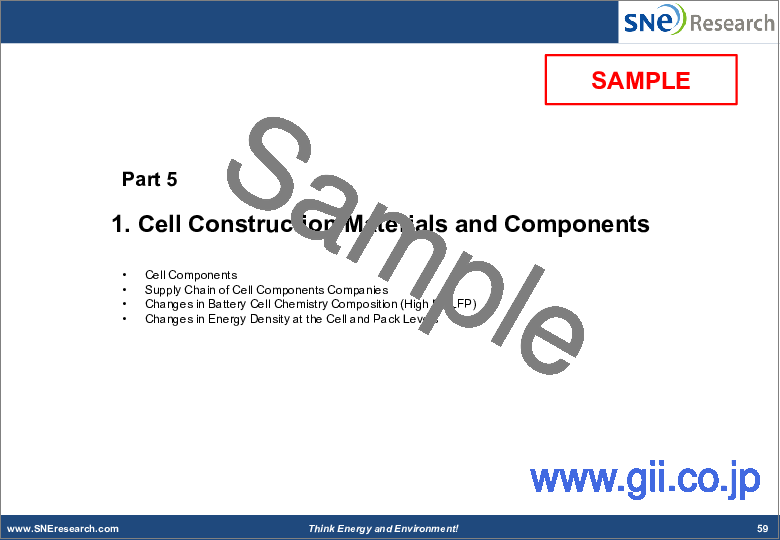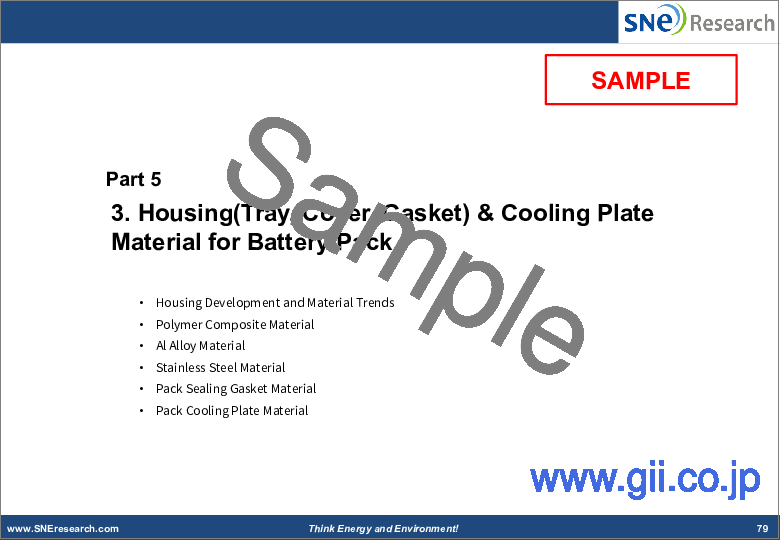|
|
市場調査レポート
商品コード
1548191
バッテリーモジュール・パック用材料の技術動向と市場見通し(~2035年)<2024> Technology Trend and Market Outlook of Materials for Battery Module and Pack (~2035) |
||||||
|
|||||||
| バッテリーモジュール・パック用材料の技術動向と市場見通し(~2035年) |
|
出版日: 2024年08月16日
発行: SNE Research
ページ情報: 英文 191 Pages
納期: お問合せ
|
全表示
- 概要
- 目次
電気自動車バッテリーの材料は、全体的な性能において重要な役割を果たしています。近年、バッテリーセル材料に関する研究や情報が急増しています。バッテリーセルはコストと使用の両面で極めて重要な部品である一方、バッテリーモジュールとパックに使用される材料は、重要性と入手可能なデータの点で比較的注目度が低いです。
BEVとPHEVの両方を含む世界の電気自動車(EV)バッテリーパックの市場規模は、2021年~2035年にCAGRで19%の成長が予測されています。EVバッテリーパックの市場金額は、2024年の1,230億米ドルから2035年までに4,620億米ドルに増加すると予測されます。セルとパックの製造コストと利益を除いた、バッテリーパック部品の市場規模は、2025年の340億米ドルから2035年までに1,130億米ドルに達すると予測され、バッテリーパック全体のコストの約25%を占めることが見込まれます。
EVパックの主要材料はバッテリーセルですが、セル間構造も重要です。しかし、エネルギー密度の向上を目指したCell-to-PackやCell-to-Chassisのような設計変更により、これらのセル間構造材料の需要は減少すると予測されます。バッテリーセル内では、正極用のニッケル、コバルト、鉄、マンガン、負極用の黒鉛(合成または天然)などの材料が、材料需要全体のかなりの部分を占めています。集電体としての銅とアルミニウムも重要な材料です。2035年に特定の材料に対する需要が大幅に減少することはないと見られますが、業界は高価なコバルトの使用から脱却しつつあり、安全性の向上を重視しています。加えて、
当レポートでは、バッテリーモジュール・パック市場について調査分析し、使用される材料の主な目的と予測される将来の動向に関する情報を提供しています。また、近年の熱暴走事故の急増と、それを防ぐために採用されている材料や開発戦略についても掘り下げています。
目次
第1部 EVとバッテリー、バッテリーパック市場の見通し
- 世界のEV市場の見通し
- 世界のバッテリーパック市場の見通し
- 世界のバッテリーパック部品市場の見通し
- バッテリーパックの主要部品のコスト構成
- EVバッテリーに使用されるバッテリーパック材料
- パックハウジング材料
- 熱管理材料
- セル間構造材料
- バッテリーセル材料の見通し
- 正極材料
- 負極材料
- セパレーター
- 電解液
第2部 バッテリーセル、モジュール、パックの主要材料の動向
- EVの種類
- EVの主要部品
- パワートレイン仕様:EVタイプ別
- EVバッテリー材料
- EVバッテリー材料のバリューチェーン構成
- セル、モジュール、パックの違い
- バッテリーセルのタイプ
- バッテリーセルタイプの検討
- バッテリーセルタイプの選択
- EVバッテリーセルタイプの選択
第3部 EVバッテリーパックの仕様分析とサマリー
- EVバッテリーパックの仕様分析
- バッテリーセル・パック価格の見通し
- 乗用車向けEVバッテリーパックの平均容量(kWh)
- EVバッテリーパックのエネルギー密度の分析(kWh/kg)
- EVバッテリーパックの使用可能エネルギーの分析
- バッテリーパックの主要部品の重量比
- 主なEVバッテリーパックの仕様の概要
第4部 バッテリーセル、モジュール、パックプラットフォームの動向
- EVプラットフォームとバッテリーパックの開発動向
- VW MEB
- HKMC e-GMP
- GM Ultium
- Tesla
- Toyota e-TNGA
- モジュールフリーバッテリーパックの特徴:BYD CTP Pack / CATL CTP Pack
- ハイブリッドバッテリーパックの利用
- ABバッテリーパックシステム
第5部 パックの主な部品
第1章 セル構成材料、部品
- セル部品
- セル部品企業のサプライチェーン
- バッテリーセルの化学組成の変化(高ニッケル、LFP)
- セル・パックレベルでのエネルギー密度の変化
第2章 バッテリーパック用熱伝導材料(TIM)
- TIMのタイプ
- TIMの主な材料
- EVへの応用事例
- TIMの形状と材料の比較
- TIMの主な考慮事項
- TIMの開発動向
- 見通し:TIMタイプ別
第3章 バッテリーパック向けハウジング(トレイ、カバー、ガスケット)、冷却プレート材料
- ハウジング開発と材料の動向
- ポリマー複合材料
- アルミ合金材料
- ステンレス材料
- パックシールガスケット材料
- パック冷却プレート材料
第4章 パックを保護する難燃性材料とソリューション
- 熱暴走
- バッテリーパックの難燃性の必要性
- 熱暴走防止ソリューション
第5章 セル間部品と材料
- モジュールを構成する材料(円筒形、角形、袋形)
- セル間の絶縁材(フォーム)
- 圧縮パッド
- 電気部品の接続(バスバー、FPCP)
- 接続電気材料の概要(銅、アルミニウム)
- 部品接合技術(はんだ付け/溶接)
第6部 主要企業の状況
第1章 セル
- セルガスケット
- Sang-A Frontec
- セルCAN
- Sangsin EDP
- Dongwon Systems
- セルパウチ
- YoulChon Chemical
第2章 モジュールとパック
- バスバー・ICBアセンブリ
- KET/Younghwa Tech/LS EV Korea/Hyunwoo Industrial/Daeduck Electronics
- ハーネスアセンブリ
- Yura Corporation/Kyungshin
- ハウジングアセンブリ
- Hanjoo Metal/Aluko/Inzi Controls/Shinsung Delta Tech
- 熱管理システム
- Hanon Systems
- 熱管理材料
- WACKER/Saint-Gobain PPL
- パックガスケット
- Dong-A Hwa Sung
- パックモジュール製造
- Sebang Lithium Battery/Amada Weld Tech Korea/Trumpf Korea
Materials within electric vehicle batteries play a critical role in overall performance. Recent years have seen a surge in research and information about battery cell materials. While battery cells are crucial components in terms of both cost and usage, the materials used in battery modules and packs have received relatively less attention in terms of importance and available data. This report focuses on the primary purposes of materials used in battery modules and packs and their anticipated future trends. The discussion of battery cells is limited to their four core components.
The global market for electric vehicle (EV) battery packs, including both BEVs and PHEVs, is projected to grow at a compound annual growth rate (CAGR) of 19% from 2021 to 2035. The market value for EV battery packs is expected to increase from $123 billion in 2024 to $462 billion in 2035. Excluding cell and pack manufacturing costs and profits, the market for components within the battery pack is forecast to grow from $34 billion in 2025 to $113 billion in 2035, accounting for approximately 25% of the total battery pack cost.
Battery cells are the main materials in EV packs, but inter-cell structures are also important. However, with design changes like Cell-to-Pack and Cell-to-Chassis aimed at increasing energy density, the demand for these inter-cell structural materials is expected to decrease. Within battery cells, materials like nickel, cobalt, iron, and manganese for the cathode, and graphite (synthetic or natural) for the anode, constitute a significant portion of the overall material demand. Copper and aluminum, serving as current collectors, are also crucial materials. While there seems to be no significant decline in demand for specific materials through 2035, the industry is moving away from the use of expensive cobalt and focusing on enhancing safety. Additionally, this report delves into the recent surge in thermal runaway incidents in battery modules and packs, and the materials and development strategies being employed to prevent such occurrences.
This report provides updated information on companies including Sang-A Frontec, Sangsin EDP, Dongwon Systems, Yulchon Chemical, KET, Younghwa Tech, LS EV Korea, Hyunwoo Industrial, Yura Corporation, Kyungshin, Hanjoo Metal, Aluko, Inzi Controls, Shinsung Delta Tech, Hanon Systems, WACKER, Saint-Gobain PPL, Dong-A Hwa Sung, Sebang Lithium Battery, Yamada Weld Tech Korea, and Trumpf Korea.
Table of Contents
Part 1. EV and Battery, Battery Pack Market Outlook
- Global EV Market Outlook
- Global Battery Pack Market Outlook
- Global Battery Pack Components Market Outlook
- Cost Configuration of Major Battery Pack Components
- Battery Pack Material Used for the EV Battery
- Pack Housing Material
- Thermal Management Material
- Inter-cell Structure Material
- Outlook for Battery Cell Material
- Cathode Material
- Anode Material
- Separator
- Electrolyte
Part 2. Trends of Major Component Material of Battery Cell, Module, Pack
- Types of EV
- Main Components of EV
- Powertrain Specification for Each Types of EV
- Battery Materials of EV
- Value Chain Configuration of EV Battery Material
- Difference of Cell, Module, Pack
- Types of Battery Cell
- Consideration of Battery Cell Type
- Selection of Battery Cell Type
- Selection of EV Battery Cell Type
Part 3. EV Battery Pack Specification Analysis and Summary
- EV Battery Pack Specification Analysis
- The Outlook for Battery Cell and Pack Prices
- Average Capacity(kWh) of EV Battery Packs for Passenger Cars
- Energy Density Analysis(kWh/kg) of EV Battery Packs
- Usable Energy Analysis of EV Battery Packs
- Weight Ratio of the Battery Pack Major Components
- Major EV Battery Pack Specification Summary
Part 4. Battery Cell, Module, Pack Platform Trend
- Development Trends of EV Platform and Battery Pack
- VW MEB
- HKMC e-GMP
- GM Ultium
- Tesla
- Toyota e-TNGA
- Features of Module-free Battery Pack : BYD CTP Pack / CATL CTP Pack
- Application of Hybrid Battery Pack
- AB Battery Pack System
Part 5. Main Components of the Pack
1. Cell Construction Materials and Components
- Cell Components
- Supply Chain of Cell Components Companies
- Changes in Battery Cell Chemistry Composition (High Ni, LFP)
- Changes in Energy Density at the Cell and Pack Levels
2. Thermal Interface Materials (TIM) for Battery Packs
- Types of TIM
- Main Materials of TIM
- Application Case for EV
- Comparison of TIM Shape and Material
- Main Considerations of TIM
- Development Trend of TIM
- Outlook by TIM Type
3. Housing(Tray, Cover, Gasket) & Cooling Plate Material for Battery Pack
- Housing Development and Material Trends
- Polymer Composite Material
- Al Alloy Material
- Stainless Steel Material
- Pack Sealing Gasket Material
- Pack Cooling Plate Material
4. Flame Resistant Material and Solution for the Pack Protection
- Thermal Runaway
- Necessity of Battery Pack Flame Resisting
- Thermal Runaway Prevention Solution
5. Inter-cell Components and Materials
- Component Materials Comprising Modules (cylindrical, square, pouch-type)
- Insulating Material between cells (Foams)
- Compression pad
- Connecting Electrical Components (Busbar, FPCP)
- Summary of Connecting Electrical Components Materials (Copper, Al)
- Connecting Component Junction Technique (Soldering / Welding)
Part 6. Major Companies Status
1. Cell
- Cell gasket
- Sang-A Frontec
- Cell CAN
- Sangsin EDP
- Dongwon Systems
- Cell Pouch
- YoulChon Chemical
2. Module and Pack
- Busbar & ICB Assembly
- KET / Younghwa Tech / LS EV Korea / Hyunwoo Industrial / Daeduck Electronics
- Harness Assembly
- Yura Corporation / Kyungshin
- Housing Assembly
- Hanjoo Metal / Aluko / Inzi Controls / Shinsung Delta Tech
- Thermal Management System
- Hanon Systems
- Thermal Management Materials
- WACKER / Saint-Gobain PPL
- Pack gasket
- Dong-A Hwa Sung
- Pack Module Manufacturing
- Sebang Lithium Battery / Amada Weld Tech Korea / Trumpf Korea






